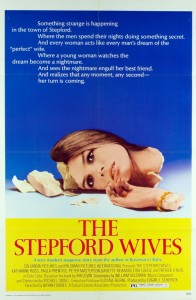 Over the years, the roles of women in horror movies have significantly changed. Some would argue that they are much better than in years past. Rather than the damsel-in-distress, we now have characters that are physically stronger and who take the villain head-on.
Over the years, the roles of women in horror movies have significantly changed. Some would argue that they are much better than in years past. Rather than the damsel-in-distress, we now have characters that are physically stronger and who take the villain head-on.
Heroines are much more common but sadly more times than not, the end result is a sexist perspective of what a woman should be. Stereotypical masculine qualities are shown and in an apparent but unstated message, we are told that the best type of woman is the one that acts like a man.
In modern horror movies, brawn is superior to brains and fear is the equivalent of weakness. Not only do the characters end up as insulting caricatures that are part-Super Hero and part She-Man, but the conclusions are often ruined by the implausible actions taken by the main characters.
The easiest, saddest and most blatant example, to point to, is in the remake of Texas Chainsaw Massacre (2003). In the movie, Erin (Jessica Biel) witnesses all of her friends massacred by an insane family. She finally escapes and instead of going for help and expressing the normal human emotion of fear, she turns around and goes after Leatherface. She’s angry, fierce and incredibly dumb.
There are more than just a few problems with this scenario. First and foremost, it’s unbelievable. Anyone who has just endured a tragedy of that magnitude isn’t going to turn into Ms. Badass. A more understandable reaction is to go insane or to have a nervous breakdown.
If nothing else, a primal instinct of survival would definitely kick in. The survivor, man or woman, would do whatever it took to escape. The last thing on her mind would be to fight back. She would be broken. To expect this Super Human behavior is demeaning to women by making them feel badly about experiencing normal emotions. More so, it just makes for a bad horror movie. If the main characters are not afraid, the viewers will not be afraid either.
In the original TCM, the lone survivor, Sally (Marilyn Burns) gives a much more terrifying and realistic portrayal. She narrowly escapes with her life and as she jumps in the back of a pick-up truck, she laughs almost maniacally. She has gone mad. After all that she had just endured, her psyche became fractured if not broken beyond repair. This is a normal human response to an absolutely insane situation, and because of that any viewer can see themselves act in the same way. Merely, being able to relate to the character on that very human level is what makes the connection with the audience so strong; and it is within that connection that a fear for the lead character is created.
Not every female lead needs to lose their marbles or run away scared to be believable. There are situations where fighting back is the only option that makes sense. It is then that the actress must be nothing short of spectacular to pull off the role. They need to be able to relay a level of complete fear and apprehension with every step, yet all the while still enforcing the necessity of continuing on their dangerous path.
Very few actresses have the ability to walk the line between coward and Super Hero – between damsel and conqueror; but when executed correctly, the result is something amazing. It is on these occasions where the audience can witness the epitome of female strength. It adds so much to the horror genre, and it is here that women are not only an asset to the genre but the driving force behind it.
The greatest female heroine of all time has to be Joanna Eberhart (Katherine Ross)in the original The Stepford Wives (1975). The rights of women were finally being discussed and taken seriously. The fear of being forced back into the role of second class citizen was driving the movement. The equality and level of intelligence of women were constantly being doubted and questioned by some very powerful and very arrogant men who wanted nothing more than to silence what they viewed as the weaker sex.
It is this fear that The Stepford Wives preys on so brilliantly. Joanna and her husband Walter (Peter Masterson) moves to a small town in Connecticut with her children. Walter joins an all men’s club who have sinister intentions. It is soon apparent that the town’s women who were once a group of progressive thinkers have all turned into men pleasing, cleaning machines who have no interest outside of the home.
Joanna does everything she can to escape. Even her psychiatrist suggests that she leaves town. Only the men take her children and she must return and risk her own life to get her children the hell out.
What makes Joanna perfect is that she is so human. She doesn’t want to return to her house. She doesn’t want to go anywhere near Stepford but as a devoted mother she hasn’t a choice.
Ross wisely doesn’t portray Joanna as a Super Hero. No. She’s scared to death as anyone would be. With every single step, the viewers can feel Joanna’s trepidation but her continuing on also makes all the sense in the world. Any mother would do it.
Not only is The Stepford Wives one of the greatest horror productions of all time, but because of Ross’s performance, it also has one of the greatest female heroines of all time.
Sadly, for every Ross we have a dozen performances like Kelly Rowland in Freddy vs. Jason. I don’t think I ever cheered so much for a character to be killed. What is the point in having a character poke fun at the monster? Even in a horror-comedy, the evil presence needs to be the terrifying factor. Even if someone is forced to fight or die, they should not poke fun at the killer. At the end of the day, Rowland had no place in horror and her character is a dark cloud on the otherwise mediocre horror entry.
I sincerely wish that the powers-that-be would understand that there is a happy medium between Judith O’Dea’s performance as Barbara in Night of the Living Dead (1968) and Patricia Tallman’s portrayal of the same character in the remake. Women can be strong without being superwomen, they can be fearful without being weak, and they can have a survivor’s instinct without seeking out the villain.

